Generative AI is everywhere. It’s in your inbox. In your marketing. In the code you deploy.
What is generative AI? At its core, it’s a technology that learns patterns from data and creates new ones.
As of early 2025, 75% of organizations say they’re using it regularly. That’s up 10 points from last year.
In 2024, it pulled in $33.9 billion in private investment which is an 18.7% spike. And it’s not slowing down.
This helps in drafting emails, designing product prototypes, and writing full-fledged marketing campaigns in minutes.
Generative AI is changing how we think, build, sell, and grow.
But there’s another side to it.
OpenAI CEO Sam Altman warned that what you say to ChatGPT could one day be used in court.
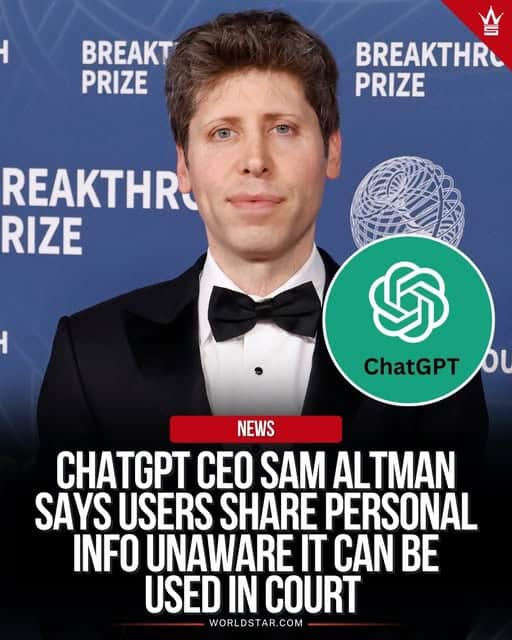
Yes, you read that right.
We’ll cover everything about Generative AI in this blog.
You’ll learn what is generative AI vs AI, how it’s different, and the popular generative AI models as of 2025. We’ll also cover how generative AI works, benefits, its limitations, concerns and so much more.
Let’s dive in.
Key Takeaways
- What is generative AI? AI systems that learn patterns from data and create new, original content (text, images, code, audio).
- What is generative AI vs AI? Traditional AI analyzes and predicts from existing data. Generative AI creates entirely new content from prompts
- What is the main goal of generative AI? To amplify human creativity by generating original content across any medium.
- Average throughput gains of 66%, performance boosts up to 40%, potential economic value of $6-8 trillion.
- Leading models include GPT-4o for general use, Claude 4 for coding, Midjourney for images, and Sora for video
- AI hallucinations, bias issues, environmental impact, and the need for human oversight remain significant concerns.
Why Everyone’s Talking About Generative AI
ChatGPT was launched on November 30, 2022. It gained 1 million users in just 5 days and reached 100 million monthly users by January 2023.
Following its launch, hundreds (if not thousands) of generative AI tools have emerged across multiple verticals.
It has fundamentally transformed the way we work, almost a complete 180-degree shift. Let’s look at a few examples:


Never Worry About AI Detecting Your Texts Again. Undetectable AI Can Help You:
- Make your AI assisted writing appear human-like.
- Bypass all major AI detection tools with just one click.
- Use AI safely and confidently in school and work.
Industry Comparison Table: Pre‑ vs Post‑Generative AI
| Industry | Before (pre‑Nov 2022) | After (2023–25, with Gen AI tools) |
| Software Development | Manual coding, debugging, documentation by hand | Tools like GitHub Copilot enabled 55.8 % faster task completion; developers saved 30 % of time on mundane tasks |
| Marketing & Customer Operations | Content creation, campaign analysis and customer service done manually | Generative AI automates creative content (emails, ads), chatbots; McKinsey estimates 75 % of Gen AI value in these functions |
| Legal / Contracts (In‑house) | Lawyers draft and review contracts manually or query external counsel | Companies like Unilever use CoCounsel and Copilot to save ~30 mins per contract review, cutting external legal fees |
| Construction & Engineering | Design, planning, maintenance predictions and safety checks done manually | Use of generative models for contract querying (RAG) improved quality by 5–9 % in construction, boosting productivity and safety |
If we look at this from a broader perspective:
- Average throughput gains = approximately 66%.
- Performance boost = up to 40%
- Economic value added = $2.6–4.4 trillion annually
- Total potential = $6–8 trillion.
That’s why everyone’s trying to understand what is generative AI? Because it’s delivering measurable results.
How It’s Different from Traditional AI
Understanding what is generative AI vs AI is critical for modern teams.
The difference between generative AI and traditional AI is like the difference between a detective and a novelist.
- One is trained to analyze clues and figure out what happened.
- The other takes an idea and creates a whole new world from scratch.
Traditional AI was built to recognize patterns.
For example, fraud detection systems in banks look at past data such as your spending habits, locations, transaction types, and flags anything that doesn’t fit.
It’s not inventing anything new, it’s simply spotting anomalies.
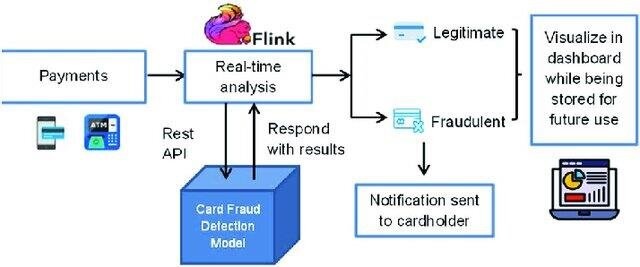
Other examples are:
- Spam filters that classify emails based on known patterns.
- Recommendation engines like Netflix or Spotify, which suggest content based on your past behavior.
- Chatbots that follow decision trees to provide predefined answers.
All of these use predictive AI meaning they take historical data, apply rules or statistical models, and output a likely result. The goal is efficiency, not creativity.
On the other hand, Generative AI generates something new that never existed before.
For example, you give AI Chat a prompt like “Write me a bedtime story about a flying toaster”, and it writes one.
You ask for a logo based on your brand’s vibe, and it designs it.
Let’s see their side-by-side difference:
| Aspect | Traditional (Predictive) AI | Generative AI |
| Purpose | Recognize, classify, predict | Create, generate, imagine |
| Input | Historical or structured data | Natural language prompts or images |
| Output | Scores, categories, predictions | Text, images, code, audio, video |
| Example | Fraud alerts, recommendation systems, spam filters | ChatGPT, Midjourney, GitHub Copilot |
| Process | Follows learned rules from existing data | Learns patterns to generate new outputs |
If we simplify both AI types, it means that:
- Traditional AI helps Netflix decide what you might want to watch.
- Generative AI could help Netflix write an entire new episode based on your preferences.
Generative AI Definition
Generative AI refers to systems that learn patterns from data and then generate new, original content whether that’s text, images, audio, video, or code.
For example, this image was created by Sora AI and has never been generated before. It’s a completely original image and concept.
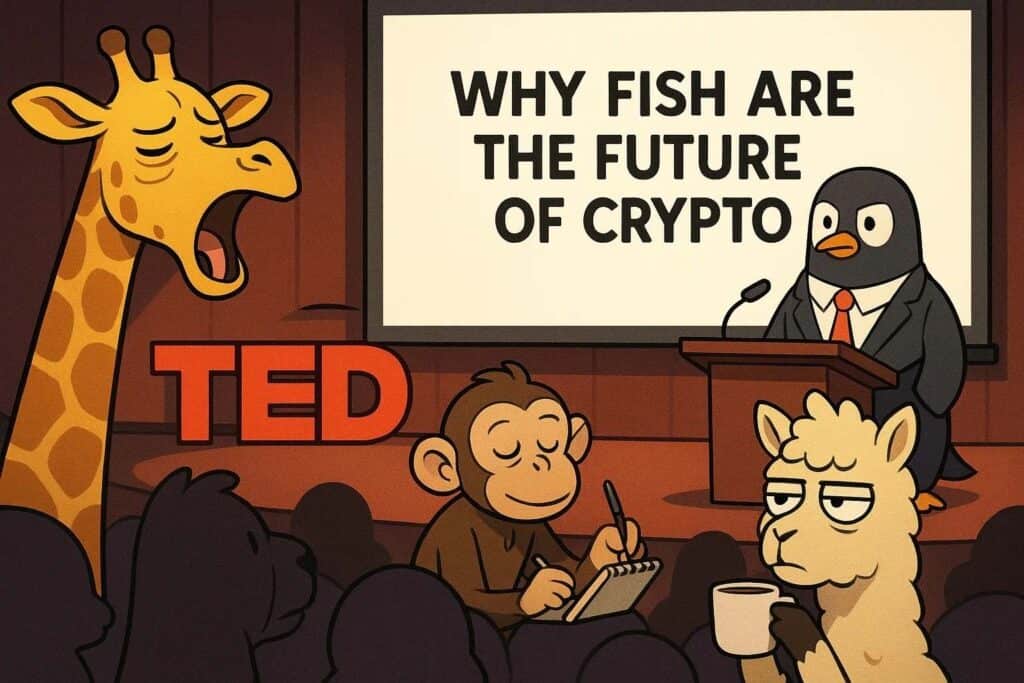
Let’s break that down simply…
These Generative AI systems are built on probabilistic models.
That means they predict what comes next based on learned patterns, instead of following a strict set of rules.
This is what allows tools like ChatGPT or Midjourney to create entirely new content from scratch.
Here’s how it works in concept:
- Step 1: The models like (ChatGPT or AI Essay Writer) are trained on massive datasets such as textbooks, codebases, audio clips, artwork.
- Step 2: It learns patterns in that data such as the structure, tone, flow, and intent.
- Step 3: When prompted, it uses those patterns to generate new outputs that feel original.
That’s the key differentiator:
- Generative AI produces novel outputs.
- Whereas discriminative models just classify or label (e.g., “this is spam”), generative models compose such as new emails, new images, new lines of code, new voices, even new songs.
The main goal of generative AI becomes clear here: to amplify human creativity by generating original content across any medium, whether that’s text, images, code, or audio
Popular Generative AI Models
Understanding what is generative ai means knowing the leading tools reshaping industries in 2025.
Generative AI spans across modalities such as text, image, audio, video, and code.
Each category now has leading and emerging players:
Text & Code
- GPT-4o (OpenAI): Fast, intuitive, and general-purpose
- Claude 4 (Anthropic): Known for its reasoning and coding accuracy
- Gemini 2.5 Pro (Google): Multimodal strength across voice, images, and video
- LLaMA 3.3 (Meta): Open-source alternative gaining traction
- Phi-4 (Microsoft): Lightweight but efficient for education and learning
- Grok 4 (xAI): Positioned for casual and social interactions
- DeepSeek: Gaining attention for math-heavy and R&D applications
Image
- Midjourney: Stylized and artistic image generation
- DALL·E 3 (OpenAI): Integrated with ChatGPT for seamless image creation
- Ideogram AI: Focused on typography and design elements
Audio
- Suno: Realistic, AI-generated music in multiple genres
- Udio: Great for voice-led tracks, podcast-style audio
Video
- Sora (OpenAI): The frontrunner for AI video generation, turning text prompts into cinematic clips
How Generative AI Works
At the core, Generative AI is all about pattern prediction.
These models don’t “know” in the way humans do, they work by calculating the most likely next word, note, pixel, or code character based on what they’ve seen before.
- Large Language Models (LLMs) Like GPT
LLMs like GPT-4.5 work by breaking down human language into tiny pieces called tokens.
These tokens could be words, parts of words, or even punctuation marks. Once tokenized, the model begins recognizing patterns and relationships between them.
LLMs are powered by a specific type of deep learning architecture known as a Transformer. This allows them to “pay attention” to context. For example:
- It understands that the word “bank” means something different in “river bank” than it does in “money in the bank.”
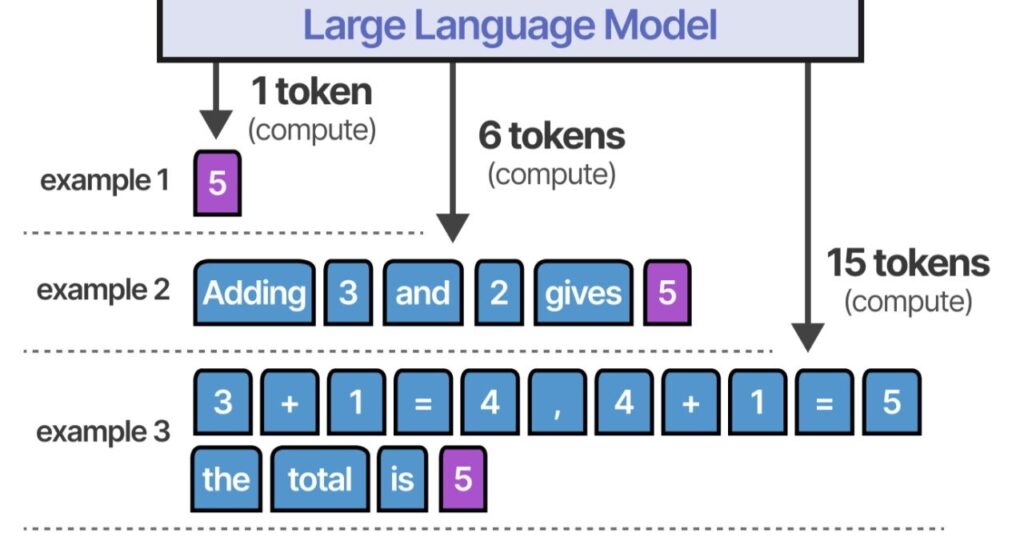
The intelligence of these models scales with size.
A model with billions (or even trillions) of parameters can make more nuanced predictions. Parameters are the internal settings the model adjusts during training.
For example:
- GPT-4.5 has significantly more parameters and contextual depth than older models like GPT-3, enabling it to write with a tone, structure, and logic that’s often indistinguishable from a human.
- Training on Massive Datasets
So where does all this “knowledge” come from?
LLMs and other generative models are trained on terabytes of diverse data.
It means that everything comes from books and articles to code repositories, Reddit threads, academic journals, and even user manuals.
The broader and more diverse the training data, the more versatile and coherent the model becomes.
However, more isn’t always better. Poor-quality data leads to poor-quality output. That’s why data curation is key.
Important Note: Some models face scrutiny for scraping content without permission. This raises ethical and privacy concerns, especially when copyrighted or sensitive data is used.
As these datasets grow, we see the rise of emergent capabilities. These are skills the model wasn’t explicitly trained on but seems to develop, like solving logic puzzles or writing poems.
- Fine-Tuning and Prompt Engineering
Base models are trained broadly, so they have to be fine-tuned to get specific.
To achieve the fine-tuning, developers train the model on niche data like legal documents or medical notes so it performs well in that particular domain.
For users, the most powerful tool is prompt engineering.
Example of prompt engineering:
- Bad prompt: Write about marketing.
- Optimized prompt: Write a 3-paragraph blog post introducing influencer marketing to small business owners, using casual tone and real-world examples.
The more specific and comprehensive you are with your input (prompts), the more accurate and desirable output you’re likely to get.
- Outputs: Text, Images, Audio, Code
What is generative AI now spans nearly every content medium:
- Text → blog posts, ad copy, social captions (GPT-4.5, Claude 4, AI Chat)
- Images → ad creatives, illustrations (Midjourney, DALL·E 3, Ideogram AI)
- Audio → music tracks, sound effects (Suno, Udio)
- Code → entire functions, bug fixes, logic trees (GitHub Copilot, GPT-4o)
In 2025, multimodal models like OpenAI’s o1 and Gemini 2.5 Pro can handle voice, video, image, and text all at once.
Common Examples of Generative AI Tools
Here’s a breakdown of the most impactful tools in 2025, showing what is generative AI capable of:
| Category | Tools | Use Case | Recommendation |
| Writing & Content Creation | – ChatGPT- Claude- AI Essay Writer– AI SEO Writer | – Blog posts, ad copy, essays- SEO content- Tone and flow refinement | Combine AI Essay Writer, and AI SEO Writer for a full-stack writing workflow |
| Image Generation | – DALL·E- Midjourney- Stable Diffusion | Visuals for ads, editorial design, product mockups | Ideal for designers, marketers, and creatives |
| Code Generation | – GitHub Copilot- Cursor- Replit | Code generation, debugging, full-stack scaffolding | Highly recommended for developers and technical teams |
| Audio & Video | – Suno- RunwayML- NotebookLM (Google) | Music, video editing, podcast/script generation | Use for creative production pipelines |
| Specialized Tools | – AI Humanizer | Refines robotic text into human-like writing | Essential for improving natural tone in AI-generated content |
Benefits of Generative AI
Here’s how Generative AI is transforming the creative and productivity landscape:
- It saves time on content production. Marketers can scale their output 10x while cutting writing time by up to 70%.
- It cuts creative costs. Hiring writers, designers, or editors can be expensive. Generative AI replaces repetitive creative labor with fast, low-cost generation.
- It increases output quality & quantity. Once you get the first draft, you can fine-tune that for tone, and format to make it high-quality and high-frequency.
- You no longer need to be a professional writer, designer, or coder. Anyone can create polished, professional-grade assets.
- It boosts productivity & creative flow. Generative AI is a relentless brainstorming partner. It helps you get unstuck, and spark new directions.
- It provides 24/7 creative assistance. It’s ready any time you need content, inspiration, or problem-solving.
Limitations and Concerns
- Hallucination Issues
AI “hallucination” means confidently generating content that is completely false.
For example: A Reddit user asked ChatGPT about homocysteine and osteoporosis, it cited a nonexistent journal article (PMID: 29033404), which actually described flame retardant overalls.
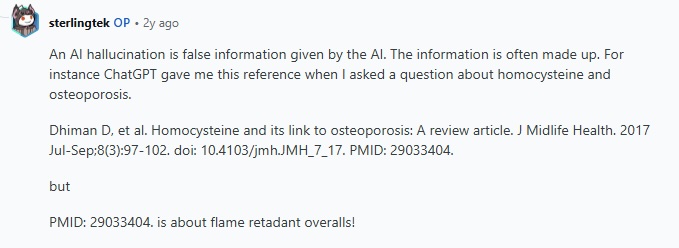
2. Ethical Concerns: Bias, Plagiarism, Misinformation
For example:
- A facial recognition system was significantly more accurate on light-skinned men than on dark-skinned individuals, reflecting underrepresentation in training data.
- A BBC audit found that chatbots like ChatGPT, Perplexity, Copilot, and Gemini regularly misstate political facts, misquote public figures, and misrepresent news context in over half of their responses on current affairs.
3. Detection Challenges
With AI content becoming harder to distinguish from human-created work, detection is increasingly important, especially in academic, legal, or journalistic contexts.
The emergence of sophisticated AI video content necessitates dedicated counter-measures to prevent misinformation.

Our Undetectable AI’s AI Video Detector provides the necessary tool, serving as a key counter-measure for AI-generated video content verification. You can use two tools in this case:
You can use two tools in this case:
- AI Plagiarism Checker identifies reused or borrowed text.

- AI Detector and Humanizer flags AI-generated content and then writes it in humanized tone and style.
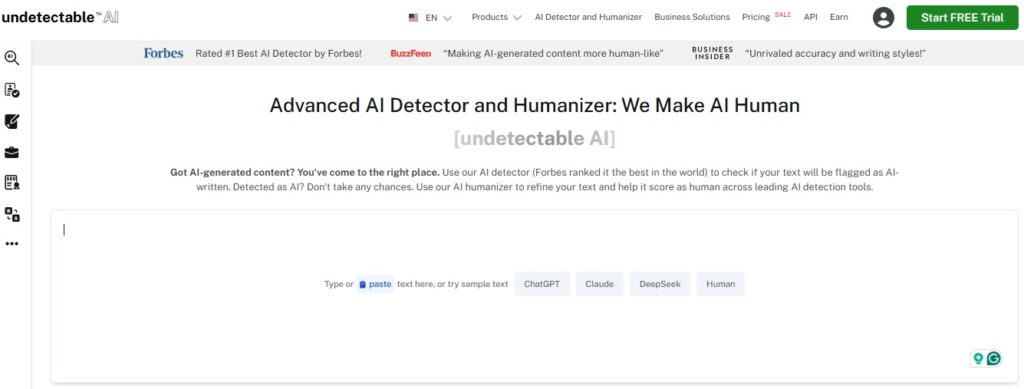
4. Over‑Reliance & Need for Human Judgment
Relying solely on AI outputs without editorial oversight can lead to factual errors, ethical missteps, or content tone that misaligns with the brand.
AI lacks true understanding so human review remains essential.
5. Quality Inconsistency & Iteration Fatigue
Output quality varies by prompt, context, and model type. Even expert users must iterate prompts multiple times for usable results, especially when nuance or accuracy matters.
This adds hidden time costs despite AI speed.
6. Environmental Impact
For example:
- Training a single NLP model can emit over 600,000 pounds of CO₂ which is equivalent to a car’s lifetime output or hundreds of transcontinental flights.
- GPT‑3 reportedly consumed ~700,000 liters of water during training. Each 10–50 response queries use about 0.5L for cooling hardware.
- Deloitte reports that by 2030, electricity use from AI could rise 24×, and generative models may consume up to 4600× more energy than traditional AI systems.
Work smarter—analyze and improve your content with just one click below.
FAQs About Generative AI
Is generative AI the same as ChatGPT?
No. ChatGPT is one example of generative AI. Other Generative AI models include Midjourney, Suno, AI Chatbot etc.
What’s the difference between machine learning and artificial intelligence?
Artificial Intelligence is the overarching umbrella. Machine Learning is a subset of AI that learns from data.
Generative AI is a subtype of Machine Learning focused on creating new content or data.
What are the main types of machine learning models?
Supervised, unsupervised, reinforcement, and generative.
What’s the difference between generative and predictive AI?
Generative AI creates new content or data, while Predictive AI forecasts outcomes based on existing data.
Final Thoughts
We stand at a crossroads now. Generative AI is changing how we think about creativity itself.
Think about it…
For the first time in human history, we have machines that don’t just calculate or categorize, but actually create.
They write stories that make us laugh.
Design logos that capture brand essence.
Code solutions to problems we haven’t even articulated yet.
What does this mean for human creativity?
The answer depends entirely on how we choose to use these tools.
The question isn’t whether generative AI will change your industry—because it already has.
The question is whether you’ll be a participant or a spectator in what comes next.
Use tools like Undetectable AI’s AI Plagiarism Checker, AI Detector and Humanizer, AI Essay Writer, AI SEO Writer, and AI Chat to stay ahead of the curve—ethically, intelligently, and creatively.
Try Undetectable AI now and create content that’s bold, human, and future-ready.
